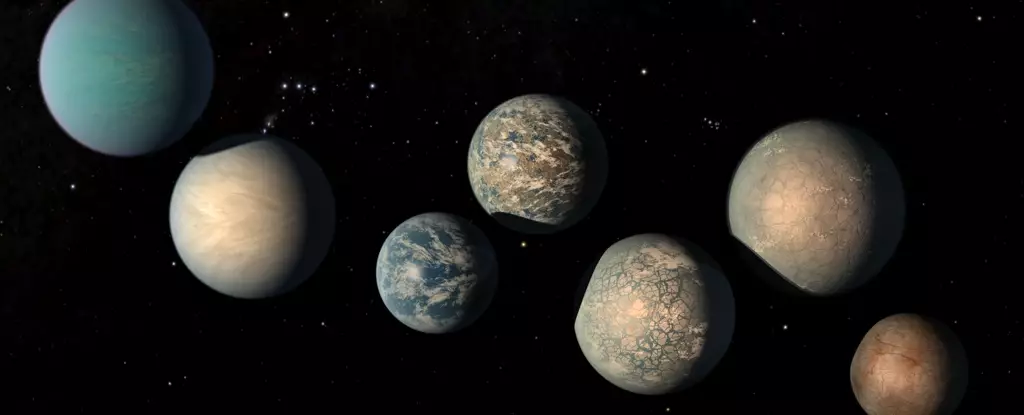The pursuit of extraterrestrial life has long captivated humanity, sparking questions that extend beyond our world and into the starry expanse of the universe. Recent discoveries within the TRAPPIST-1 system have intensified this intrigue, particularly after findings suggested that water—a fundamental ingredient for life—could be present on its seven planets. Situated approximately 40 light-years away, this enigmatic collection of exoplanets orbits a red dwarf star, TRAPPIST-1, which has become a focal point for astronomers and astrobiologists alike.
Since its discovery in February 2017, the TRAPPIST-1 system has been the subject of extensive study, with researchers continually monitoring it for biosignatures. Among the most exciting developments is the potential for these planets to host water, a key element for sustaining life as we know it. However, the discourse surrounding the habitability of the TRAPPIST-1 planets is riddled with complexities that must be navigated with care.
The Role of Red Dwarfs in Exoplanetary Habitation
M-type stars, or red dwarfs, are fundamentally different from our Sun. Smaller, cooler, and notoriously prone to flare-ups, these stars challenge traditional models of planet habitability. Flares from red dwarf stars can strip away atmospheres and influence planetary climates significantly. Therefore, understanding the impact of their stellar behavior on surrounding planets is crucial in assessing their potential for habitability.
One intriguing aspect of the TRAPPIST-1 system is the controversial debate concerning water availability. Some scientists have posited that planets orbiting red dwarfs may experience an excess of water but are at risk of losing it swiftly due to intense ultraviolet radiation. This precarious balance necessitates deeper investigation to fully grasp the realities of water’s presence on these exoplanets.
Latest Research: A Closer Look at Water Sources
A groundbreaking study led by astrobiologist Trent Thomas from the University of Washington has shed light on the enigmatic atmospheric conditions of TRAPPIST-1 c. Contrary to prior assertions that it possessed a Venus-like carbon dioxide-heavy atmosphere, new data suggest otherwise. More significantly, this research acknowledged the potential for water vapor to exist, necessitating the presence of continual water sources.
To better understand these dynamics, Thomas and his team created a theoretical outgassing model aimed at determining water release dynamics on these rocky planets. Drawing upon geological knowledge from our own Solar System, they evaluated outgassing rates and volcanic activity among TRAPPIST-1’s seven worlds. The implications of their findings indicate that while outgassing could occur at rates between 0.03 to eight times that of Earth, the likelihood of substantial volcanic activity remains low.
Low Volcanic Activity: A Double-Edged Sword
The revelation that the TRAPPIST-1 planets may experience minimal volcanic activity casts a shadow on their prospects for habitability. While the possibility of outgassing suggests some capacity for water retention, the inference that these planets may mirror the geothermal inactivity of Mars is disconcerting. Should they follow the trajectory of Mars, they may be condemned to an existence devoid of active geological processes that often rejuvenate atmospheres and foster conditions for life.
The research further posits that these planets might possess drier mantle compositions than previously considered. This insight prompts speculation about the viability of retaining liquid water, raising urgent questions regarding the quantity and distribution of water and how that aligns with the various planetary archetypes ranging from barren rocks to potential ‘water worlds.’
Implications for Future Research
The tantalizing potential for life in the TRAPPIST-1 system is strong, yet fraught with uncertainty. If these planets do indeed possess mechanisms for sustaining water, what does that mean for future explorations of habitability? The Webb Space Telescope has only begun to scratch the surface of what can be learned from these celestial bodies. Continuous observations will be pivotal in refining the understanding of whether these planets can sustain life or if they are merely geological curiosities, rich in water yet devoid of biological potential.
While the TRAPPIST-1 system poses numerous questions and presents significant challenges, it is also an epitome of cosmic wonder. It serves not only as a testing ground for theories of planetary formation and evolution but as a reminder of the vast complexities of life—an enigma that we are only starting to comprehend. With ongoing observations and research, the path ahead could reveal transformative insights about our universe and the possibility of life beyond Earth. The destiny of TRAPPIST-1’s planets may remain uncertain, but the journey toward understanding them is undoubtedly a thrilling endeavor for scientists and dreamers alike.

